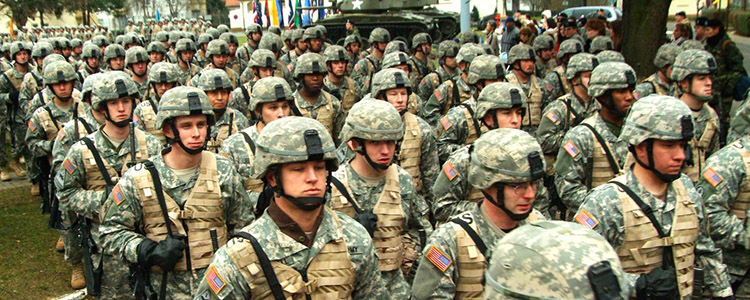Marching In Formation Raises Confidence And Changes Mindset

(Inside Science) -- When the police in Ferguson, Missouri, marched down the street, armed, armored and in lockstep during the recent rioting, anthropologists could predict three things would happen:
The police would feel emboldened and strong because they were marching in synchrony; the people they were marching toward would feel threatened and weak, and the police would make decisions they would not have made if they were not in formation and some of those decisions would likely be wrong.
The result usually makes a bad situation worse.
Marching served a purpose recognized through history, said Daniel M. T. Fessler, an evolutionary anthropologist at the University of California, Los Angeles. Fessler and a colleague, Colin Holbrook, just published a paper in the journal Biology Letters on marching into battle.
The people marching -- the in-group -- get one message; the people they are marching toward -- the outgroup -- get another.
Almost every army does it, he said, and so do many police forces. There is the famous Archibald McNeal Willard painting of three American soldiers during the Revolution, one with a flag, one with a fife, the third with a drum leading a march. Fessler said the British army, dressed in bright red and gold, marched to combat during the war and were cut down by Americans wearing camouflage and hiding behind trees. That was essentially the last time an army used that tactic, but marching remains part of training.
"Marching clearly builds unit cohesion," he said. "It builds confidence in fighting ability."
When units of the British army marched into various wars with bagpipes and drums leading the march, they were not doing it just because of tradition. It is part of an evolved psychology.
Anthropologists call it synchrony, and it applies not just to soldiers and police. Football teams show it. So do religious rituals. Further, many animals behave the same way.
And Ferguson is not the only example; Fessler said he began his research after what most people consider a police riot at MacArthur Park in Los Angeles in 2007. The Los Angeles Police Department fired rubber bullets at protesters and struck them with batons. The police response cost the city millions in settlements.
"The police were organized and armed, and they were primed for battle. Their equipment, their formation, their movement, all of those things were, I think, being processed by a part of our mind that basically tries to reach a conclusion of 'whether we can take that guy.'"
"That predisposes one to aggressive action," he said.
"The reason that experience has the result that it does is because a very old part of our psychology is to recognize how effective our coalition is in situation of potential conflict," Fessler said.
In the experiment reported in the new paper, men were found to make judgments about the size and threat posed by an angry male in a mugshot. When they were walking in synchrony with a companion, the estimates of size were smaller than when they walked alone. Fessler and Holbrook have done almost a half-dozen similar experiments.
In another, men standing with friends guessed the threat of a man in a mugshot differently than men who were alone. To the latter group, he was bigger, more threatening.
"Just the proximity of allies is enough to change the adjustment about relative fighting capacity," he said.
Fessler believes any vertebrate can make decisions on potential threat from size and strength. The use of synchronized behavior as a demonstration of strength is not universal in the animal world, but it exists. Anthropologists call it convergent evolution: the same attribute evolves independently in different species.
"Tons of animals do it," said Marc Bekoff, also an evolutionary biologist at the University of Colorado Boulder, including chimpanzees, coyotes, wolves, and elephants. In birds it's called mobbing, Bekoff said, the reason birds form flocks.
Dolphins may be the best example of synchronous behavior. Mature male dolphins will often form gangs that act in consort, said Richard Connor, a biologist at the University of Massachusetts Dartmouth. Sometimes a gang will raid another group of dolphins to steal females, particularly those ready to reproduce. They will defend themselves from attacks by other gangs who want the females.
Sometimes one gang will ally itself with another to build a more formidable force, again acting in synchrony.
Weaker members of the group are emboldened by the stronger members of the group when they act together, whether in dolphin gangs, armies or police forces.
Sometimes in humans, it does not work out.
"In Ferguson, when people have to make decisions quickly in a situation of violent conflict, evolved mechanisms in the mind can play an important role in the decisions that they make, and make calculations based on things we wouldn't necessarily want decisions to be based on, like 'can we take those guys,'" Fessler said.

